|
Have a safe day!
Thursday, May 9
2:30 p.m.
Theoretical Physics Seminar - Curia II
Speaker: Sonny Mantry, Northwestern University/Argonne National Laboratory
Title: Event Shapes for Exclusive Jet Processes: From the LHC to the EIC
3:30 p.m.
DIRECTOR'S COFFEE BREAK - 2nd Flr X-Over
THERE WILL BE NO ACCELERATOR PHYSICS AND TECHNOLOGY SEMINAR TODAY
Friday, May 10
3:30 p.m.
DIRECTOR'S COFFEE BREAK - 2nd Flr X-Over
4 p.m.
Joint Experimental-Theoretical Physics Seminar - One West
Speaker: David Schmitz, University of Chicago
Title: Quasi-Elastic Scattering of Neutrinos and Anti-Neutrinos at MINERvA
Click here for NALCAL,
a weekly calendar with links to additional information.
Ongoing and upcoming conferences at Fermilab |
|
Thursday, May 9
- Breakfast: Canadian bacon, egg and cheese Texas toast
- Breakfast: Mexican omelet
- Soft steak tacos
- Smart cuisine: baked penne with chicken and mushrooms
- Stuffed boneless pork chops
- Turkey bacon panini
- Sweet and sour chicken
- Chef's choice soup
- New Brunswick stew
- Assorted pizza by the slice
Wilson Hall Cafe menu |
|
Friday, May 10
Dinner
- Spinach salad
- Alaskan crab legs
- Parsley potatoes
- Grilled asparagus
- Lemon panna cotta with blueberry sauce
Wednesday, May 15
Lunch
- Ropa vieja (braised beef, peppers, onions)
- Yellow rice with toasted cumin
- Baked custard with rum sauce
Chez Leon menu
Call x3524 to make your reservation.
|
|
Fermilab breaks ground on muon experiment building
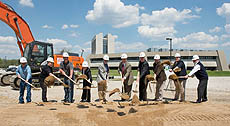 |
Representatives from the U.S. Department of Energy, Fermilab, Whittaker Construction and the architecture firm Middough Inc. break ground on a new building that will house the Muon g-2 experiment. Photo: Reidar Hahn |
On Wednesday, May 8, Fermilab and Department of Energy officials broke ground on a new building that will house the Muon g-2 experiment. The new experiment will study the magnetic wobble of muons, and the core of the experiment—a 50-foot-wide electromagnet—will be transported this summer in one piece by barge and truck from Brookhaven National Laboratory in New York. The Muon g-2 experiment will be the first to use a new beam of muons from Fermilab's upgraded accelerator complex. A second experiment called Mu2e is also planned.
View a video of the groundbreaking ceremony.
|
Registration for New Perspectives is open
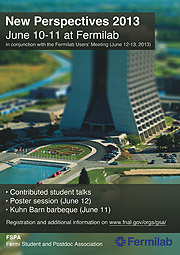 |
Registration for the New Perspectives 2013 conference and poster session is now open. |
If you're an undergraduate, graduate student or postdoc who would like to attract attention to your research on a Fermilab experiment, register now for New Perspectives 2013, which takes place from June 10-11 in Wilson Hall. The New Perspectives Poster Session follows on June 12 as part of the 46th annual Fermilab Users Meeting.
The registration deadline is June 1.
New Perspectives gives early-career scientists working on a Fermilab experiment the opportunity to present their research, often for the first time, among peers in a low-pressure setting.
Last year set a record for the number of conference submissions, so this year the Fermilab Student and Postdoc Association, which hosts the conference, is adding a half day to the traditionally one-day meeting to accommodate the growing number of participant presentations.
In addition to giving talks, participants may also submit a poster for the June 12 poster session. More information is on the FSPA website.
A barbecue at Kuhn Barn takes place on the evening of June 11.
For additional information, e-mail the FSPA officers, who will be happy to address your questions.
|
Smallest lab-made drop of liquid might cause strange particle behavior
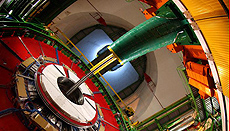 |
A new result from the CMS collaboration takes a step toward revealing the origin of the mysterious 'ridge effect.' Photo: Michael Hoch/CERN
|
The Large Hadron Collider is known for a list of impressive facts—it's the world's largest and most powerful particle collider; it accelerates particles to nearly the speed of light; its cryogenic system keeps it colder than outer space.
Now it's under consideration for a new superlative: Scientists there might have created the most minuscule drop of liquid ever formed in a laboratory.
Last year physicists collided protons with heavier lead ions in the LHC. They found a small but noticeable correspondence between the trajectories of charged particles that sped away from collisions. Newly produced particles appeared to be synced, like a school of fish moving in unison. They dubbed this phenomenon the "ridge effect."
The CMS experiment (pictured above) studied more proton-lead collisions early this year, and the result, made public this week, suggests that the particles are behaving the way they do in lead-lead collisions, where they are swept along by a drop of plasma. If this is true, the drop formed in proton-lead collisions would be the smallest drop of liquid ever formed in a laboratory.
Read more
—Kelly Izlar
|
Moving picture: Batavia man takes care of bison at Fermilab
From the Daily Herald, May 3, 2013
When Cleo Garcia of Batavia tells his friends or relatives that he works with the roads and grounds crew at Fermilab, it doesn't usually inspire a lot of jealousy.
Until he tells them that he also cares for the herd of bison that lives there.
"Then they want to come and see them, and they say that they wish they had my job," Garcia said.
Read more |
Quantum mechanics trick may detect invisible gravity waves
From space.com, May 1, 2013
The existence of gravitational waves, or ripples in space and time, has long been predicted, but the elusive phenomenon has eluded scientists for decades. Now researchers are proposing a new method to detect these cosmic wrinkles that relies on the quantum nature of atoms.
Gravitational waves are a consequence of Einstein's general theory of relativity, which posits that massive objects warp the space-time around them, causing other objects, and even light, to travel along curved paths when they pass nearby. Objects with very strong gravitational fields, such as black holes or dense stars orbiting in binary pairs, should create gravitational waves so powerful they are detectable here on Earth.
However, no experiment has yet found definitive proof that gravity waves exist. A group of physicists led by Stanford University's Peter Graham hopes to change that, though, with a new detection method they call "atom interferometry."
Read more |
|
No unknown unknowns
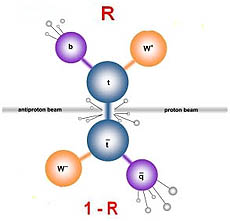 |
Proton and antiproton collide to produce a top-antitop pair. R is the ratio of the branching fraction of top → W+b to top → W+q, where q is any quark (d, s, b).
If there is no background, the number of events with one tag is proportional to 2R(1-R), and the number of events with two tags is proportional to R2. |
By studying the properties of known particles and comparing their actual measurements to calculated predictions, scientists can investigate whether there are as yet unknown particle physics processes.
The top quark was discovered at Fermilab in 1995 and, as part of the third and final generation of quarks, completes the quark family. Because of its large mass, it decays before joining other quarks to form hadrons. This peculiarity makes the top quark a unique particle to study. When the top quark decays, the Standard Model predicts that most of the time (more than 99.83 percent) it decays into a W boson and a b quark.
What if the top decays into a W and a b quark less often than expected? To answer this question, CDF scientists looked at events where a top-antitop pair is produced. These events are identified by the presence of a W boson decaying into a charged lepton (electron or muon), a neutrino and several jets. The number of jets originating from a b quark depends upon the number of tops decaying into W+b with respect to the number of top quarks decaying into W+q where q is any kind of quark with charge -1/3 (d, s, b). This ratio is called R. If the Standard Model is correct, then this ratio should be almost one.
Scientists at CDF have looked into the full data set, collected during the 10 years of Tevatron Run II. They measured the number of times the top decays into a W boson and a b quark with respect to the total number of top decays and compared this number with expectations. R is measured as a function of lepton type, the number of jets in the event (three, four, five or more) and identified b-tags (one, two). This measurement was performed simultaneously with a measurement of the cross section for top-antitop pair production (the cross section is a measurement of the number of times an event occurs). The results are shown in the lower plot.
CDF measured that R is equal to 0.94 ± 0.09, which is consistent with Standard Model expectation. This shows there are no unknown processes at the level indicated by the accuracy of the measurement. An important number for physicists is Vtb, which gives the strength of the coupling between the t and the b quark. Making some standard assumptions, |Vtb|= 0.97 ± 0.05, or |Vtb| > 0.89 at the 95 percent credibility limit.
Learn more
—edited by Andy Beretvas
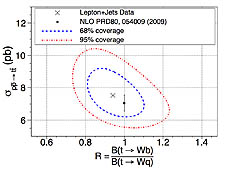 |
The fit results for the simultaneous measurement of the top-antitop cross section and R. The X near the center of the graph corresponds to the data. The point with an error corresponds to a Standard Model calculation.
|
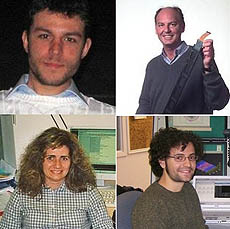 |
These physicists, all from INFN Pisa, were responsible for this analysis. Top row from left: Pierfrancesco Butti, Georgio Chiarelli. Bottom row from left: Sandra Leone and Federico Sforza.
|
|
Sunning siblings
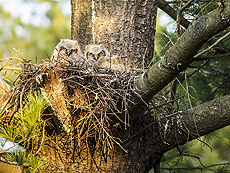 |
A recently rescued owlet in apparently good health sits in his cozy nest next to his sibling. Photo: Marty Murphy, AD |
|
|